Imagine sitting in a cozy café—the quiet hum of conversation blending with the clinking of cups, the gentle hiss of an espresso machine, and soft background music setting the mood. Then, a song from your high school years plays, and suddenly, you’re transported back in time. You feel the same emotions as if it were yesterday.
Sound has a unique way of shaping our experiences and connections. It influences emotions, enhances communication, and builds lasting memories. Whether through music, voice tone, or sound design, understanding how to use sound effectively can transform how people engage with your content.
The Power of Sound
We often think about sound as a byproduct of things around us—but its impact runs much deeper.
Sound connects us in ways no other medium can. It’s the foundation of music, language, and storytelling. It shapes cultures, makes brands unforgettable, and turns ordinary spaces into community hubs or isolating voids.
Sound is influence. When used intentionally, it creates emotional responses, strengthens communication, and leaves an imprint that resonates long after it’s heard.
The Science of Sound
Think about the sound of your mother’s voice. How does it make you feel?
Or the way a crashing ocean wave can bring calm, while a city’s buzz can energize.
Sound is deeply tied to emotion and memory. It can alter heart rates, trigger fight-or-flight responses, or guide us into a meditative state. Research shows that sound can relax muscles, boost hormone production, and increase blood flow.
It’s more than just noise—it’s a tool. Use it wisely.
Why Your Voice Matters
Everyone has a story to tell. But how you communicate that story determines whether people listen—or tune out.
Your voice’s tone, pace, and energy shape how you’re perceived.
A high-pitched, rushed voice can come across as uncertain or anxious.
A slower, deeper tone commands attention and conveys confidence.
Want to connect more deeply with your audience? Listen to your own voice. Adjusting your tone and delivery can make a significant impact.
Music: The Universal Language
Music is woven into human experience. It transports us through time, evokes powerful emotions, and unites people across cultures.
Think about how a song from decades ago can instantly bring back memories—you remember every lyric, every feeling.
Music isn’t just entertainment—it’s direction. It tells the brain how to feel, what to recall, and how to respond.
A simple experiment? Play different songs in a room full of people and watch how it changes their behavior. Learn what resonates with your audience, and use that knowledge to shape their experience.
The Art of Sound Design
Great sound design is invisible—it guides attention without drawing attention to itself.
Whether in animation, drama, or even a quick social media clip, thoughtful sound design enhances engagement.
Voice connects the audience to a story.
Music makes them feel.
Sound design pulls them in, creating tension, release, and immersion.
A single sound—subtle or bold—can shift an entire experience. And this transformation doesn’t need hours to unfold. A single second of the right sound can make an impact.
Harnessing Sonic Memories
Think back to the commercials and cartoons from your childhood.
The jingles and sound effects? You probably still remember them. That’s the power of sound—it stays with us.
As creatives, our job is to build those memories for the future. The sounds we design today will trigger nostalgia decades from now.
Sound isn’t just about the present—it’s about creating lasting impressions.
Sound in the Digital Age
Attention spans are shorter than ever. Platforms like Instagram and TikTok have changed how we consume content, and sound is the fastest way to stand out.
Short, memorable sound clips can interrupt scrolling patterns.
Signature sounds and meme music help content go viral.
The first five seconds matter—use them wisely.
If you’re not leveraging sound in digital content, you’re missing an opportunity.
The Power of Podcasts & Audiobooks
Podcasts and audiobooks offer the longest audience engagement of any medium.
A podcast listener might spend hours with your content, building a direct and personal connection. But poor sound quality? That’s a dealbreaker.
Listeners won’t tolerate thin, distorted, or overly reverbed audio. They’ll move on to content that’s easier on the ears.
Similarly, AI-narrated audiobooks lack human nuance—and audiences can feel it. If you can, hire a real narrator (or better yet, read it yourself). Your listeners will thank you.
Embracing Immersive Audio
Technologies like Dolby Atmos and Apple Spatial Audio are transforming how we experience sound. These formats create a 3D audio environment, making storytelling more immersive than ever.
Sound is no longer just in front of us—it’s around us.
For creators, this is an opportunity to push storytelling further. With immersive audio, we can transport audiences into the experience, making them feel like they’re truly part of the world we’re creating.
This is engaging audio at its peak.
Final Thoughts: Use Sound with Intention
Sound is one of the most powerful storytelling tools we have. Use it well.
Your voice shapes perception.
Music directs emotion.
Sound design guides attention.
When used thoughtfully, sound doesn’t just enhance experiences—it creates them.
Now, go make something amazing.







